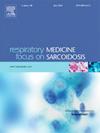Modification of asthma treatment efficacy by healthcare access: A reanalysis of AsthmaNet Step-Up Yellow Zone Inhaled Corticosteroids to Prevent Exacerbations (STICS) clinical trial
IF 3.5
3区 医学
Q2 CARDIAC & CARDIOVASCULAR SYSTEMS
引用次数: 0
Abstract
Background
While randomized controlled trials (RCTs) in asthma management are designed to balance known and unknown variables across treatment groups, including social and environmental co-exposures, it remains important to consider how these co-exposures influence disease progression and treatment outcomes. The importance of considering socio-environmental co-exposures in the context of asthma is twofold: 1) asthma disproportionately affects low-income urban communities, where air pollution and chronic stress are pervasive; and 2) despite the wide range of asthma treatments, inadequate disease control persists.
Methods
In the present ancillary study of the Step-Up Yellow Zone Inhaled Corticosteroids to Prevent Exacerbations (STICS) RCT, we investigated how socio-environmental factors, such as air pollution exposure and healthcare access, modify the effect of inhaled corticosteroid (ICS) therapy in children with asthma. The original STICS RCT evaluated the efficacy and safety of increasing the dose of inhaled glucocorticoids from a baseline daily low dose to five times the daily dose for 7 days in school-age children with mild -to-moderate persistent asthma who began to have short-term loss of asthma control (Jackson et al., 2018 Mar 8) [1]. Our study adds onto those findings by incorporating residential level particulate matter 2.5 μg/m3 (PM2.5) and geographic health provider shortage areas (HPSA) as potential modifiers.
Results
Consistent with the main trial results, we did not find a difference in the number of exacerbations between treatment arms. However, we found the effect of receiving 5xICS, as compared with 1xICS on the time to prednisone was significantly different for children living in areas a shortage of health professionals (HR: 2.09; 95 % CI: 0.74, 5.95) than for children living in no shortage areas (HR: 0.40; 95 % CI: 0.21, 0.77).
Conclusion
This finding underscores the importance of considering environmental and social factors in asthma treatment.
Trial registration
ClinicalTrials.gov ID NCT02066129 https://clinicaltrials.gov/study/NCT02066129.
医疗服务对哮喘治疗效果的影响:哮喘网 "黄色区域吸入皮质类固醇预防病情恶化"(STICS)临床试验的再分析。
背景:虽然哮喘治疗的随机对照试验(RCT)旨在平衡各治疗组的已知和未知变量,包括社会和环境共同暴露,但考虑这些共同暴露如何影响疾病进展和治疗效果仍然非常重要。考虑哮喘的社会环境共同暴露有两方面的重要性:1)哮喘对城市低收入社区的影响尤为严重,因为这些社区普遍存在空气污染和慢性压力;2)尽管有多种哮喘治疗方法,但疾病控制仍不充分:在本项 "黄色区域吸入皮质类固醇预防病情恶化研究"(STICS)的辅助研究中,我们调查了社会环境因素(如空气污染暴露和医疗保健服务)如何改变哮喘儿童吸入皮质类固醇(ICS)治疗的效果。最初的 STICS RCT 评估了将吸入糖皮质激素的剂量从基线的每日小剂量增加到每日剂量的 5 倍并持续 7 天的疗效和安全性,适用于开始出现短期哮喘控制丧失的轻度至中度持续性哮喘的学龄儿童(Jackson 等,2018 年 3 月 8 日)[1]。我们的研究将居住水平颗粒物 2.5 μg/m3(PM2.5)和地理上的医疗服务提供者短缺地区(HPSA)作为潜在的调节因素,对这些发现进行了补充:与主要试验结果一致,我们没有发现治疗组之间的病情加重次数存在差异。然而,我们发现,与 1xICS 相比,接受 5xICS 对泼尼松用药时间的影响,生活在医疗专业人员短缺地区的儿童(HR:2.09;95 % CI:0.74, 5.95)与生活在非短缺地区的儿童(HR:0.40;95 % CI:0.21, 0.77)有显著差异:结论:这一发现强调了在哮喘治疗中考虑环境和社会因素的重要性:试验注册:ClinicalTrials.gov ID NCT02066129 https://clinicaltrials.gov/study/NCT02066129。
本文章由计算机程序翻译,如有差异,请以英文原文为准。
求助全文
约1分钟内获得全文
求助全文
来源期刊

Respiratory medicine
医学-呼吸系统
CiteScore
7.50
自引率
0.00%
发文量
199
审稿时长
38 days
期刊介绍:
Respiratory Medicine is an internationally-renowned journal devoted to the rapid publication of clinically-relevant respiratory medicine research. It combines cutting-edge original research with state-of-the-art reviews dealing with all aspects of respiratory diseases and therapeutic interventions. Topics include adult and paediatric medicine, epidemiology, immunology and cell biology, physiology, occupational disorders, and the role of allergens and pollutants.
Respiratory Medicine is increasingly the journal of choice for publication of phased trial work, commenting on effectiveness, dosage and methods of action.
 求助内容:
求助内容: 应助结果提醒方式:
应助结果提醒方式:


